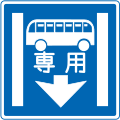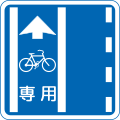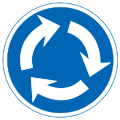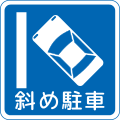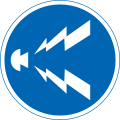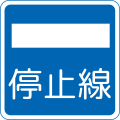Road signs in Japan
In Japan, road signs (道路標識, dōro-hyōshiki) are standardized by the "Order on Road Sign, Road Line, and Road Surface Marking (道路標識、区画線及び道路標示に関する命令)" established in 1968 with origins from the Tokyo Metropolitan Police Department's "Order on Standardization of Road Sign" of 1934 and the Home Ministry of Japan's "Order on Road Signs" of 1942. The previous designs have been used since 1986 after several amendments of order.
Warning signs[change | change source]
-
Crossroads
-
T-intersection with road on the right
-
T-intersection with road on the left
-
T-junction
-
Y-junction
-
Roundabout ahead
-
Gentle curve to the right
-
Gentle curve to the left
-
Sharp curve to the right
-
Sharp curve to the left
-
Double gentle curve, first to the right
-
Double gentle curve, first to the left
-
Double sharp curve, first to the right
-
Double sharp curve, first to the left
-
Winding road, first curve to the right
-
Winding road, first curve to the left
-
Railroad crossing ahead
Option 1: steam locomotive -
Railroad crossing ahead
Option 2: electric train -
School ahead
-
Traffic signals ahead
-
Slippery road
-
Fallen rocks
-
Uneven surface
-
Traffic merges from the left
-
Left lane ends
-
Road narrows on both sides
-
Two-way traffic ahead
-
Steep descent (10%, 1:10)
-
Steep ascent (10%, 1:10)
-
Men at works
-
Crosswind
-
Watch for large animals (deer)
-
Watch for large animals (rabbit)
-
Watch for large animals (monkey)
-
Watch for large animals (raccoon dogs)
-
Be careful
Regulatory signs[change | change source]
-
Road closed to all
-
Road closed to vehicles
-
No entry
-
No motor vehicles except motorcycles and mopeds
-
No trucks
-
No bus
-
No motorbike or mopeds
-
No non-motorized vehicles except bicycles
-
No bicycles
-
No motor vehicles
-
No two-person motorbike or mopeds
-
Straight ahead or left turn permitted
-
Straight ahead or right turn permitted
-
Turn left
-
Turn right
-
No turns
-
Turn left or right
-
Directions permitted
-
Keep left
-
Keep right
-
No crossing center line to enter e.g. a car park
-
No U-turns
-
No crossing center line to overtake
-
No stopping
-
No parking
-
Restricted parking
-
No vehicles carrying dangerous goods
-
Weight limit
-
Height limit
-
Width limit
-
Motor vehicles only
-
Bicycles only
-
Bicycles and pedestrians only
-
Pedestrians only
-
Maxiumum speed limit
-
Minimum speed limit
-
One-way street to the left
-
One way street to the right
-
One-way street ahead
-
One way (bike)
-
Trucks use left lane[1]
-
Buses-only lane
-
Bicycle lane
-
Buses-priority lane
-
Lane usage
-
Lane usage
-
Lane usage
-
Lane usage
-
Roundabout
-
Parallel parking
-
Perpendicular parking
-
Angle parking
-
Use car horns
-
Slow down
-
Road closed to pedestrians
-
No jaywalking
Instruction signs[change | change source]
-
Cyclists are permitted to ride side-by-side.
-
Driving on tram line permitted
-
Priority road
-
Center line
-
Stop line
-
Parking zone
-
Stopping permissive
-
Crosswalk
Alt. A -
Crosswalk
Alt. B: school zone -
Bike crossing
-
Bike and crosswalk
-
Controls ahead
Supplemental signs[change | change source]
Supplemental signs (補助標識, hojo-hyōshiki) are usually put just below the principal signs, and shows their valid range like time, day and category of vehicle.[2] They are equivalent to the "plaque" of the American MUTCD. The width of the plates is usually 60 cm, and the sentences should be less than 7 characters per a line or 3 lines.[3] When the sentences can not be shortened less than the limitation, they should apply changeable signs.[3]
-
100 meters ahead
-
Next 50 meters
-
Except Sundays and Holidays
-
8 a.m. to 8 p.m.
-
Except mopeds
-
Large trucks
-
Bicycles (symbol)
-
Trucks (symbol)
-
Trucks carrying over 3 tonnes (symbol)
-
Only for permitted vehicles
-
Make room more than 6 meters when you park
-
Permitted until the time the parking meter shows
-
Restriction begins (symbol)
-
Restriction begins
-
Restriction begins
-
Restricted zone (symbol)
-
Restricted zone
-
End of restriction (symbol)
-
End of restriction
-
End of restriction
-
End of restriction
-
School zone
-
No passing or overtaking
-
Give way
-
Train crossing
-
Crosswind
-
Wild animals
-
Caution
-
Safety speed: 30 km/h
-
Caution soft shoulder
-
Be quiet
-
direction
-
Control zone: Honmachi, Komoro
-
Starts
-
Ends
History[change | change source]

The first standardised road signage schemes appeared in 1922. At first, two types of signs were established: "road warning signs" equivalent to warning signs and "road guide signs" as information signs.[4] Warning signs at that time closely resembled the British design as used in Hong Kong, the only difference was the white-on-black lettering.
Japanese road signs in the early 1940s closely followed European road signage practices at that time based on the 1931 Geneva Convention, except that most road signages contained text. A variation of the early 1940s Japanese road signage system is still in use today in Taiwan.[4][5]
In 1950, a complete revision of the "Road Signs Ordinance" was promulgated and enforced as an Ordinance of the Prime Minister's Office and the Ministry of Construction. Unlike the 1922 and the 1940s devised road signs, it included both bilingual Japanese and English text and symbols. Warning signs were changed from a European red-bordered triangular design to an American MUTCD yellow diamond design. This road signage system was used until 1963, when it was replaced with a new road signage system that is based on the Vienna Convention on Road Signs and Signals. The present-day Japanese road signage system also replaced the stop sign's shape with an inverted equilateral triangle like the stop sign used in West Germany from the 1945 to 1971.
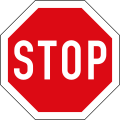
In 2016, it was announced that the Japanese National Police Agency was considering changing the design of the "Stop" sign used on Japanese roads since 1963 from the inverted red triangle sign to an octagonal design more closely conforming to the recommendations of the 1968 Vienna Convention on Road Signs and Signals.[6] The inverted red triangle sign was introduced in 1963 ahead of the 1964 Tokyo Olympic Games, and replaced the earlier red octagonal sign used from 1960, which in turn had replaced the yellow octagonal sign used from 1950.[6] It was later decided to make the stop sign bilingual in both Japanese and English, but to maintain the inverted triangular shape.[7]
References[change | change source]
- ↑ The symbol can be changed to other vehicles.
- ↑ 全標協 2013, p. 3(設置)
- ↑ 3.0 3.1 警察庁 2017, p. 32.
- ↑ 4.0 4.1 "道路標識の歴史(変遷) | KICTEC". KICTEC | 交通インフラから公共空間まで多彩な快適環境保全創りに挑みます (in Japanese). 2012-06-18. Retrieved 2023-01-24.
- ↑ "旧型道路標識一覧(禁止・指導・規制・警戒標識)". trafficsignal.jp (in Japanese). Retrieved 2022-09-09.
- ↑ 6.0 6.1 "Design of Japanese stop signs might change ahead of Olympic tourism surge". The Japan Times. Japan: The Japan Times Ltd. 21 January 2016. Retrieved 23 January 2016.
- ↑ "英語併記の新標識お目見え 一時停止に「STOP」". 日本経済新聞 電子版 (in Japanese). Retrieved 2018-01-24.



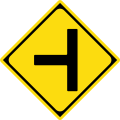






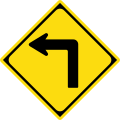

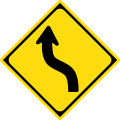






















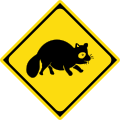


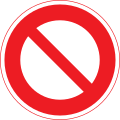


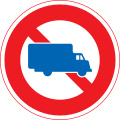












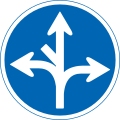
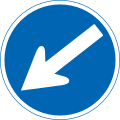







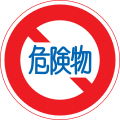

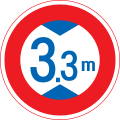
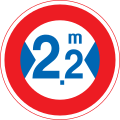

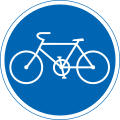








![Trucks use left lane[1]](http://upload.wikimedia.org/wikipedia/commons/thumb/2/2b/Japanese_road_sign_327-2.svg/120px-Japanese_road_sign_327-2.svg.png)
